
Since I first attended an SDC meet thanks to my parents back in 1996, I have loved Studebaker. But even I have to admit that, in the end, Studebaker did themselves in. They very nearly went under in the 1930s, but thanks to the new management team of Harold Vance and Paul Hoffman–and in no small part, healthy refinancing and restructuring–Studebaker survived the Depression. By late 1933, against all odds, the corporation was back in the black. Unfortunately, those same guys started making the decisions that led to the last South Bend Studebaker cars leaving the soon-to-be-shuttered factory in December 1963, only a few short months into the 1964 model year.
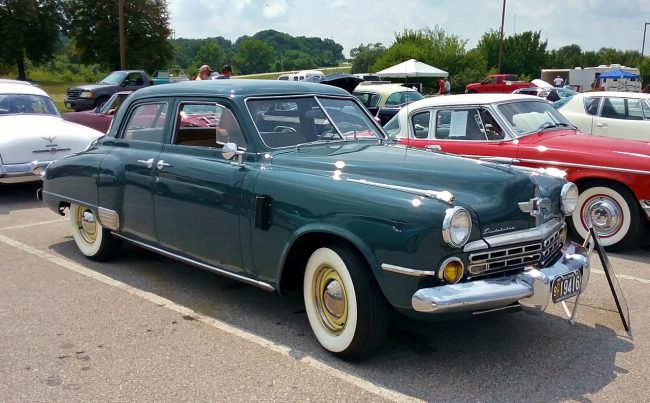
1948 Commander
Studebaker got off to a great start in the postwar era with their startlingly modern, all-new 1947 line.
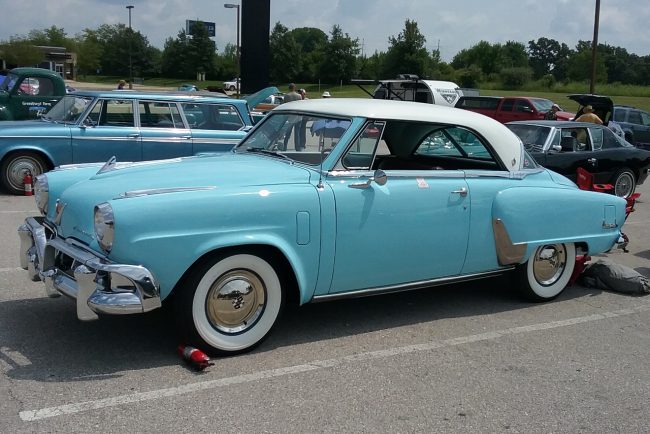
1952 Commander Starliner
With further advances such as a V8 engine and automatic transmission–both designed in-house, a major achievement for an independent–Studebaker sold lots of cars through 1952, when they celebrated their centennial anniversary.
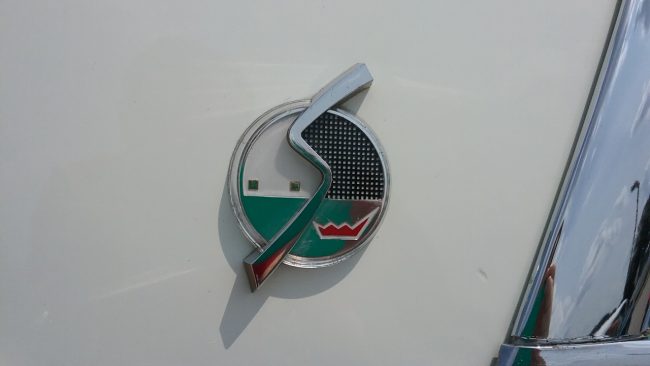
Unfortunately, trouble was right around the corner. Record sales circa 1947-52 helped them tool up for a major redesign and fresh lineup, but it had to be a hit.
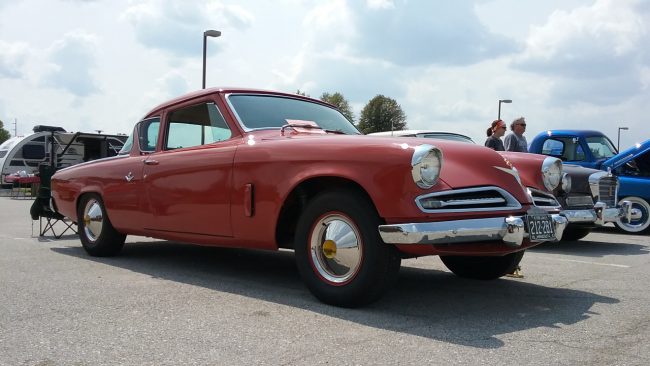
1953 Commander Starlight
The all-new 1953 models–both the beautiful coupes…
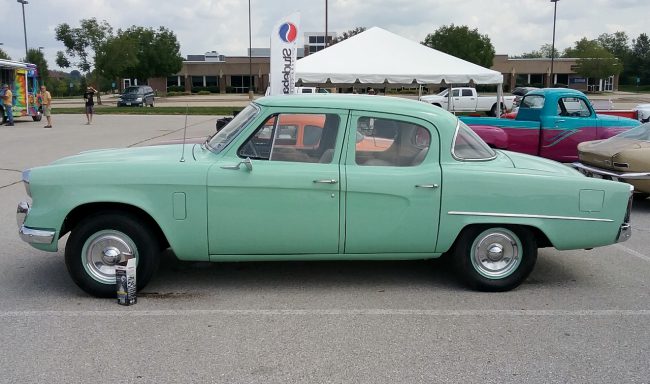
1953 Champion sedan
And the comparably stubby sedans–sold less well than Studebaker hoped. They needed a lot more sales than they got to stay in the black.
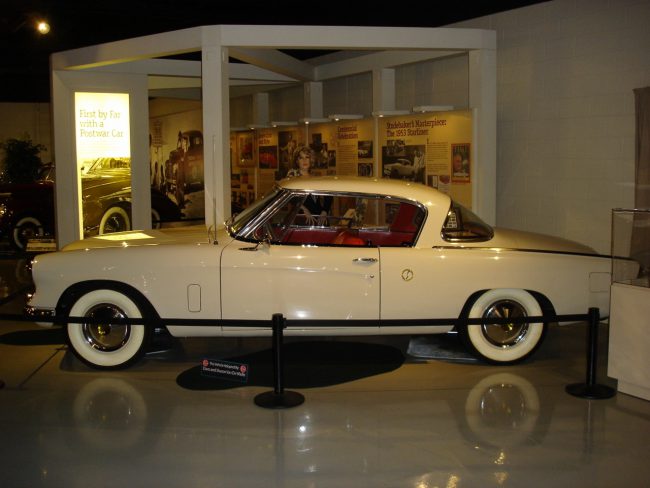
1953 Commander Starliner at the Studebaker National Museum in 2015
Trouble was, everyone and their brother wanted the sleek, sexy Loewy coupes. Studebaker had not anticipated the demand, because traditionally, their bread and butter were two- and four-door sedans, not coupes.
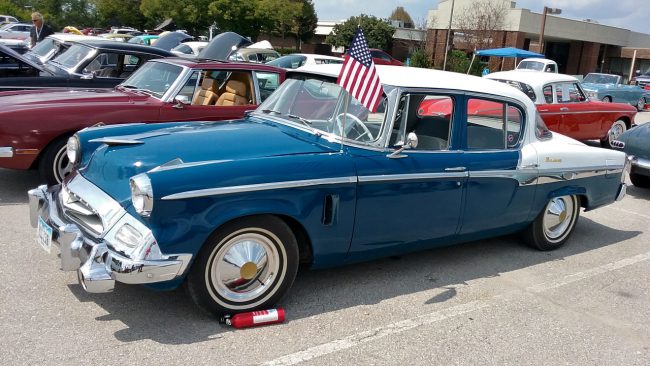
1955 President
That’s not to say that Studebaker stopped making neat cars after the 1953 models didn’t live up to the company’s-and in some cases their customers’-expectations.
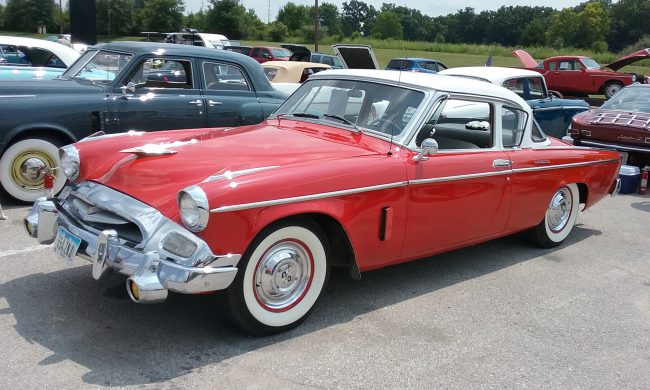
1955 Commander
Their classic Loewy coupes, handsome E Series (later Transtar) pickups, innovative Wagonaire and many other models were attractive and interesting–but sales continued their downward trajectory.
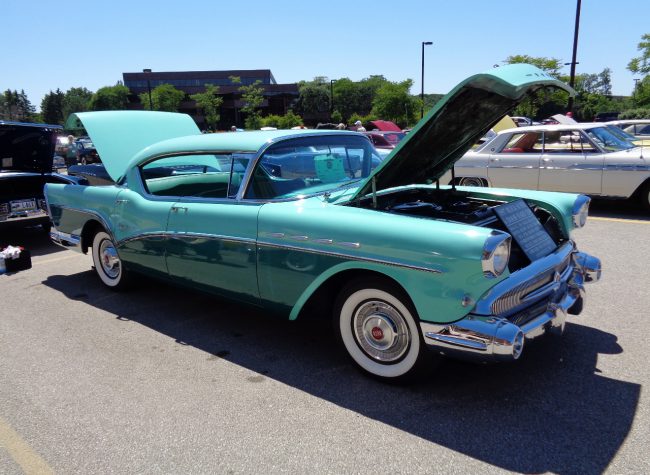
1957 Buick Super
And meanwhile over at GM, Ford and Chrysler Corporation, new designs, new gadgets and even more deluxe models were making the warmed-over ’53 bodies look also ran by comparison.
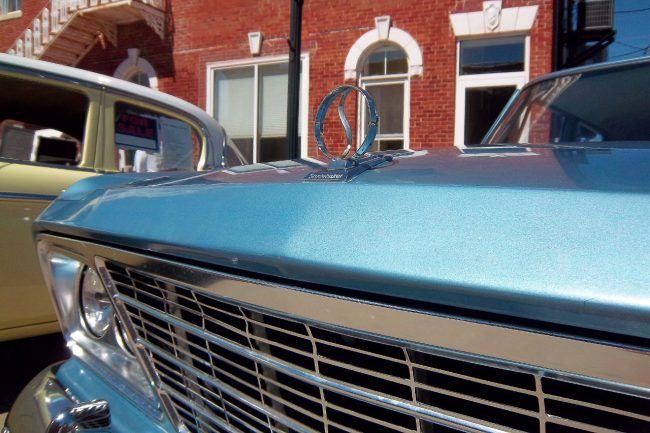
The Studebaker story is oft-told. So I won’t go too deeply into it. It’s hard for me to do a post on a Studebaker and not start in on the history of the company, and all the stuff that happened. Woulda, coulda, shoulda, et al!
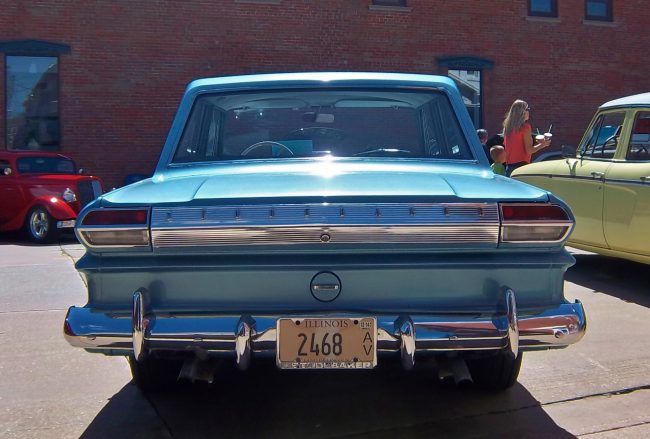
That said, one big problem was that Studebaker didn’t control their costs. Whatever the workers wanted, they got, and with nary a cross word from management.
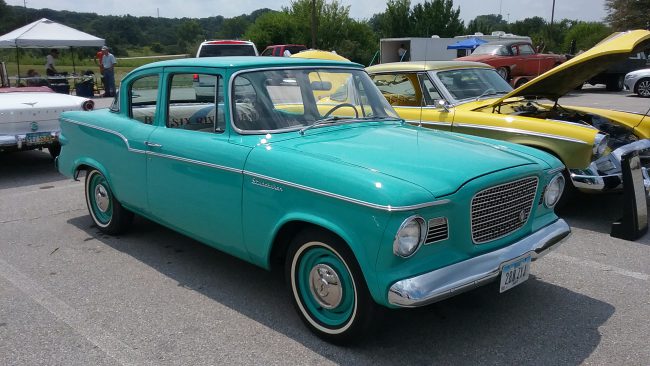
That led to astronomical production costs compared with the Big Three, and Studebaker’s rapidly aging facilities complicated matters further. The success of the ’59 Lark provided a brief reprieve, but when the Falcon, Corvair and Valiant debuted, it was back to the same-old, same-old.
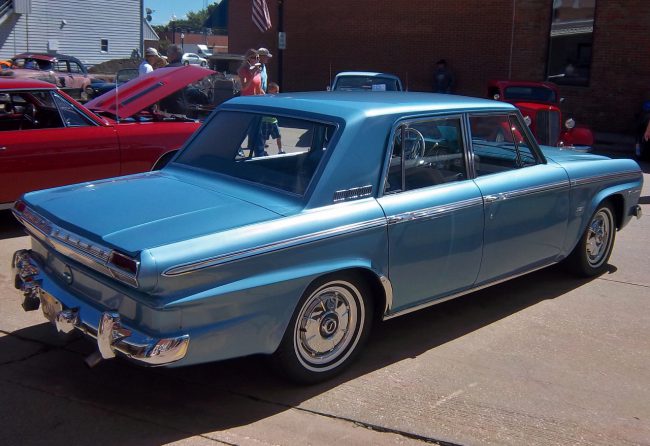
And thus do we come to the 1964 Studebakers. Brooks Stevens, the renowned Milwaukee-based industrial designer, was a godsend to small companies like Studebaker. He had quite a knack for taking a shoestring budget and delivering a major refresh that looked great. What would be his last assignment for Studebaker was the 1964 model refresh. There’s a 1959 Lark under there, but it isn’t immediately obvious.
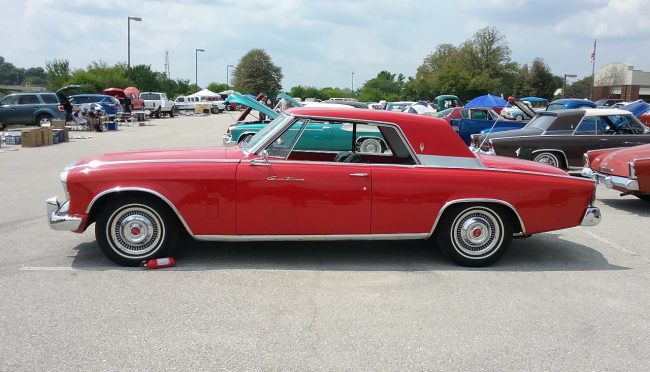
1963 Gran Turismo Hawk
He first worked his magic in 1962, with the Mercedes-like 1962 Larks. They looked to be all-new, thanks to clever styling, but were the same old Lark. Sales increased over 1961. That same year, with perhaps his best design ever, the Gran Turismo Hawk appeared, looking surprisingly modern with its shorn fins and Thunderbird-style roofline. The transformation from the befinned 1956-61 Hawk was remarkable.
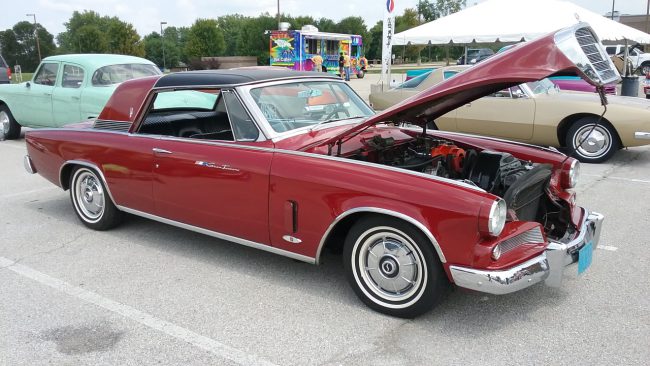
1964 R2 GT Hawk
Studebaker had spent most of the early ’60s clinging to relevance. Had it not been for Sherwood Egbert, Studebaker may have had even less time left than they ultimately got. But Egbert, going against orders to shut down Studebaker, instead tried his best to keep it going, hiring Stevens to come up with new styling, introducing the Avanti, and setting records at the Bonneville Salt Flats with Andy Granatelli-prepped R1- and R2-powered Hawks and Avantis.
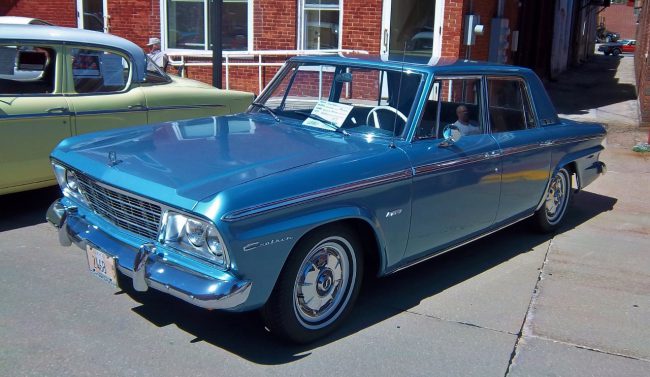
Egbert did all he could to keep Studebaker afloat, but unfortunately his effort didn’t translate into any meaningful sales increase. Illness forced his retirement from Studebaker in November 1963; almost immediately, the Studebaker board approved shutting down South Bend in favor of limited production at their Canadian facility. The last Indiana-built car came off the line December 20, 1963. At the same time, production of all light- and heavy-duty truck lines, the Avanti, and the GT Hawk ended for good.
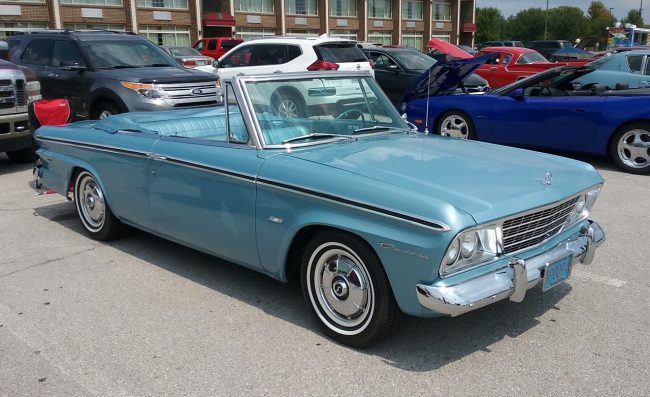
But not before the last “new” Studebakers came out in the fall of 1963. While technically still Larks, the name was not seen on the car. Instead, the names of different trim lines–Challenger, Commander, Daytona and Cruiser–were emphasized. Studebaker may not have had much time left, but they still had quite a good-looking car as well as attractive, colorful interiors.
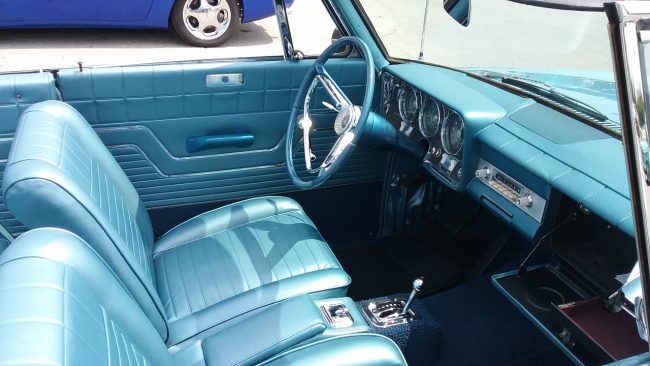
The instrument panel was particularly sharp. In contrast to so many other domestic cars, the Stude had full instrumentation. And the optional tachometer was placed right there on the dash with the other gauges, unlike the difficult-to-read, center-console-mounted tachs in some GM and Ford products. Despite all their troubles, Studebaker still offered many thoughtful, intelligent design features.
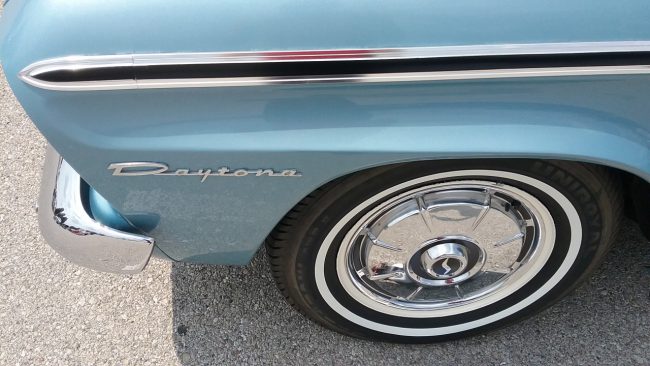
In addition to more modern, squared-off sheet metal, there was power if you wanted it. The aforementioned R1 through R4 power options resulted in a sedate little Studebaker that could potentially suck the doors off unsuspecting Sport Furys, Impala SSs, and Fairlane 500s.
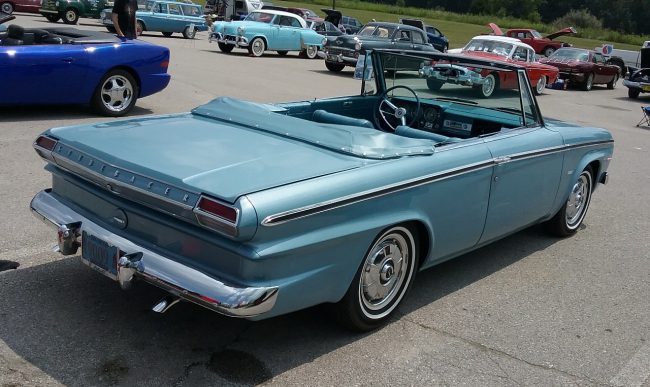
You could even get disc brakes, but you’d have to hurry, as only South Bend-built Studebakers got the R-spec equipment. The denuded Canadian-built 1964 lineup would be limited to bread-and-butter family cars, not hot rod Avantis, Larks or GT Hawks. And no convertibles!
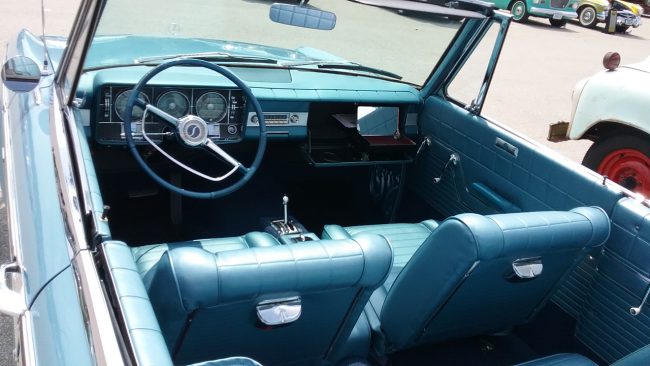
Yes, the beautiful Daytona convertible, with its fresh sheetmetal and most excellent interior, would disappear with the closing of the South Bend factory in December of ’63.
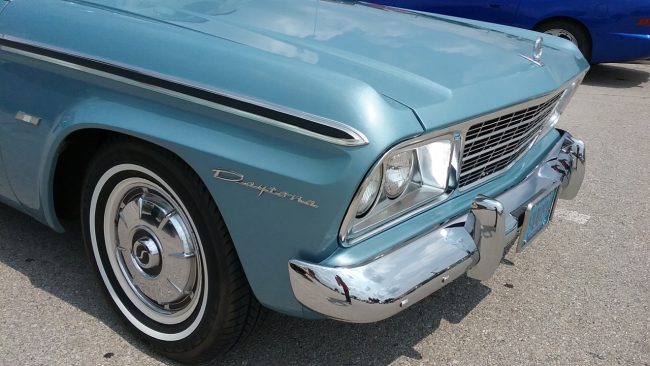
All Canadian Studes would have a fixed metal roof-unless you sprung for a Wagonaire with the retractable roof!
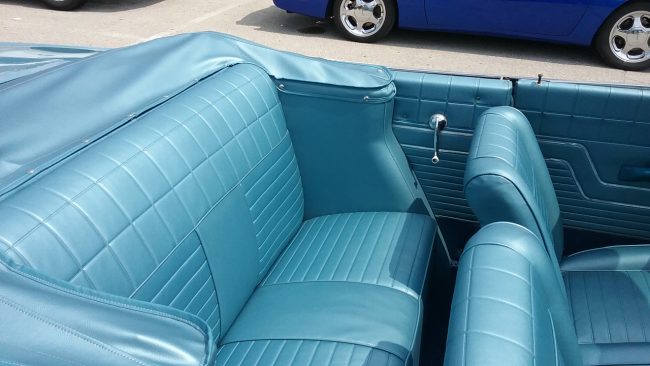
With the ’64 redesign, Studebaker deemphasized the Lark nameplate, and so all non-Hawk Studebakers were emblazoned with their trim levels: Daytona, Commander, Cruiser, etc. The Daytona convertible retailed for $2797.
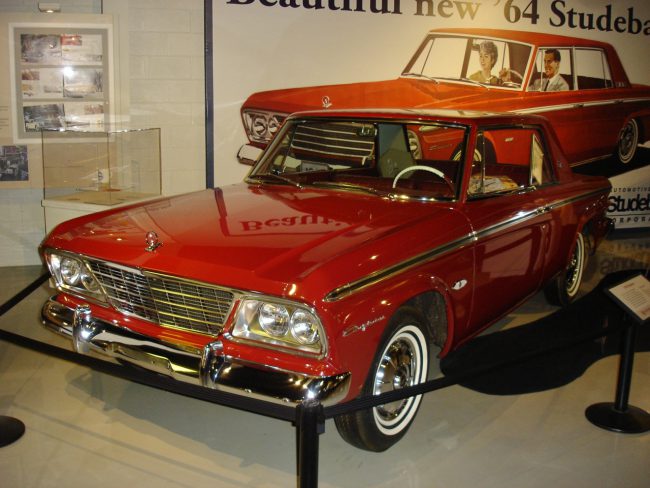
The last South Bend built Studebaker made, seen by Klockau in July 2015.
According to my Standard Catalog of American Cars 1946-75, only 647 Daytona convertibles were built between the introduction of the 1964 models and the closure of South Bend on December 20, 1963. The final Indiana car built was a two-door Daytona V8 hardtop. Like the convertible, there would be no pillarless two-doors once production moved to Hamilton.
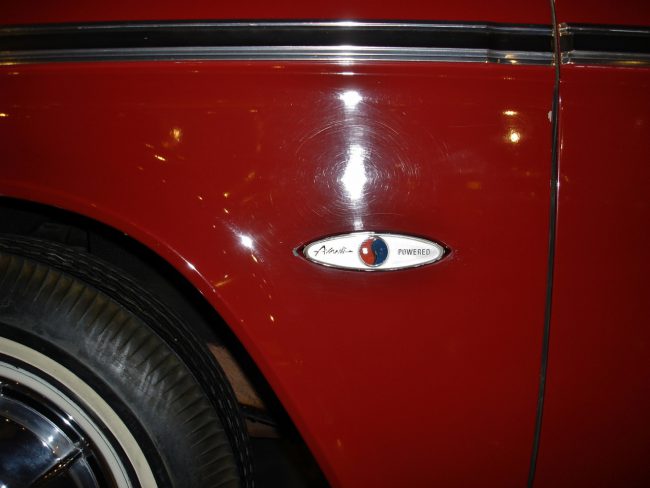
And it was sporting some serious firepower under the hood! Yep, an R1.
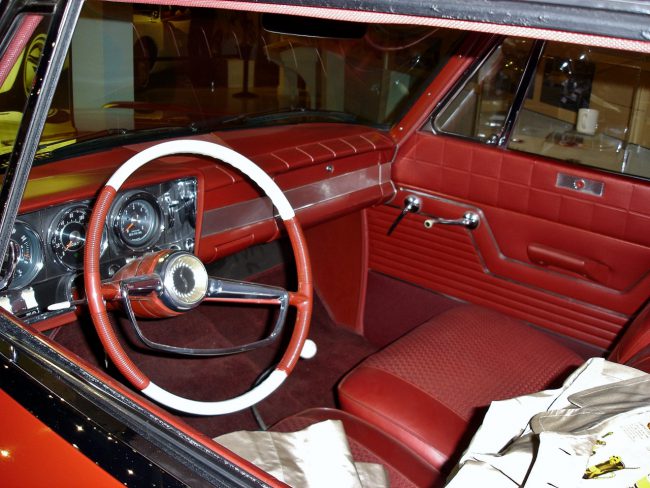
And a red interior. The car survives in showroom condition at the Studebaker National Museum in South Bend. Tell Andrew Beckman that I sent you, if you visit, ha ha.
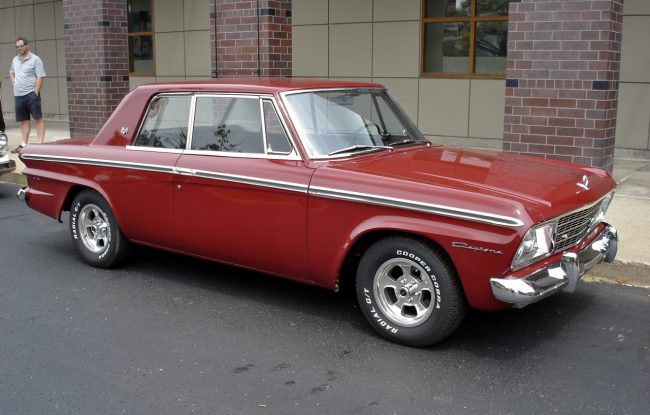
I got to see his personal Studebaker back in 2015 when I visited with Jim Cavanaugh. We also got to see a bit of the museum archives, which was very cool. I highly recommend the museum to any gearhead who happens to find themselves in central Indiana.
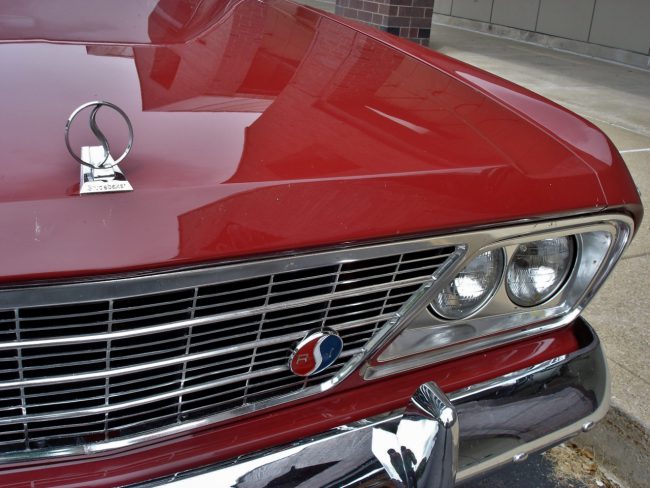
Oh, and Mr. Beckman’s Daytona sounded very healthy indeed when he pulled up out front to meet us.
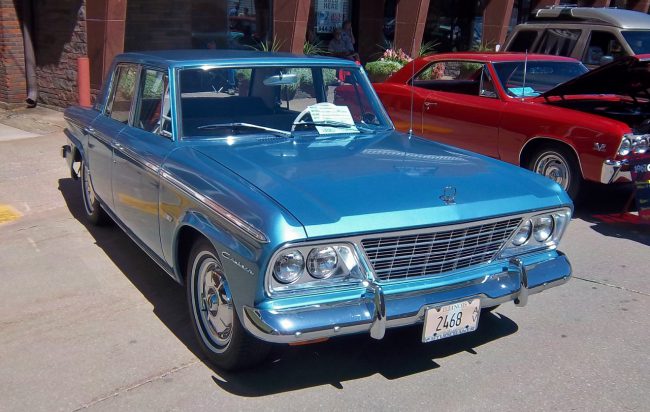
But if you wanted luxury and not necessarily a hot rod, you needed look no further than the Cruiser. As in the past, the Cruiser nameplate designated the finest Studebaker you could get. While previous versions of the Cruiser had merited a longer wheelbase than lesser Studes, the 1964 model had the same 113″ wheelbase and 194″ overall length as the other ’64 four-door sedans. Price? $2,595. 5,023 were built.
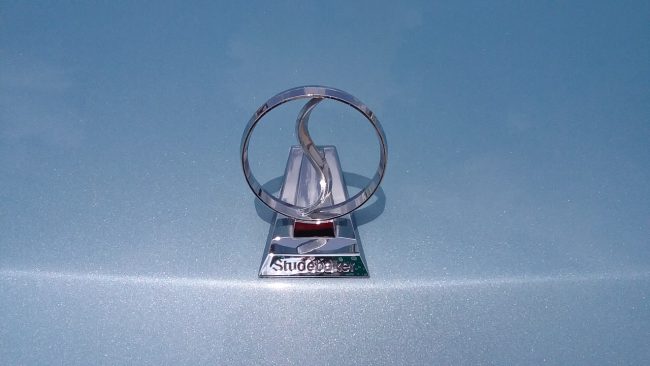
The attractive, new-for-1964 “Lazy S” hood ornament was indeed appropriate for the luxurious Cruiser; it also graced all other Larks except the entry-level Challenger model. In fact, this picture is of the 1964 Daytona convertible, spotted just last month at an SDC zone meet in Iowa City, IA.

It’s just a happy coincidence that both cars are painted in Laguna Blue, an original Studebaker color. It’s very sharp, whether on the Cruiser sedan or the Daytona convertible. But who doesn’t love a convertible?
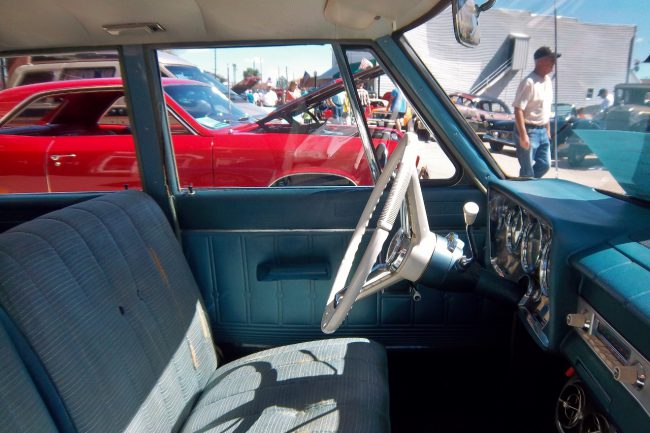
Cruiser features included a standard Thunderbolt 289 cu in V8 (although some export Cruisers were built with the six), plush cloth interior, wall-to-wall carpeting and extra chrome trim inside and out. Available only as a four- door sedan, the $2,595 Cruiser ran about $650 above the cheapest Lark, the $1,935 six-cylinder Challenger two- door sedan.
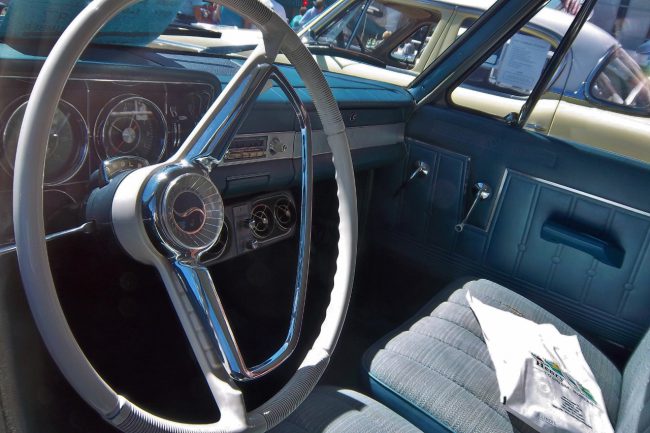
As with our featured Cruiser sedan, most ’64s got a clock instead of a tachometer. I think this may be one of the most attractive instrument panels of the ’60s: all business, but with just enough chrome trim to let you know you’re in something a cut above.
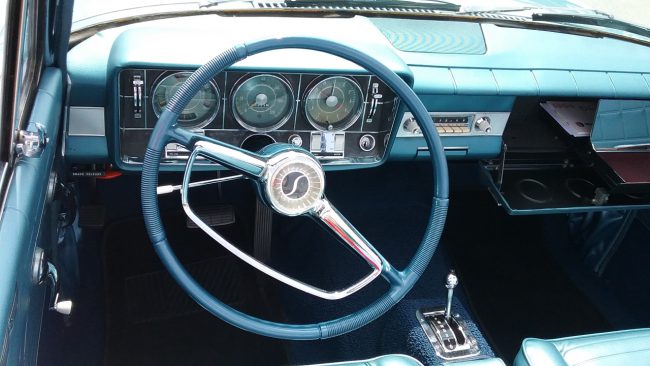
Even our sporty topless Daytona feature car, resplendent in Laguna Blue with matching blue bucket seat interior and floor-shift automatic transmission, had the clock instead of the tach. Well, Studebaker buyers were a somewhat more practical bunch!
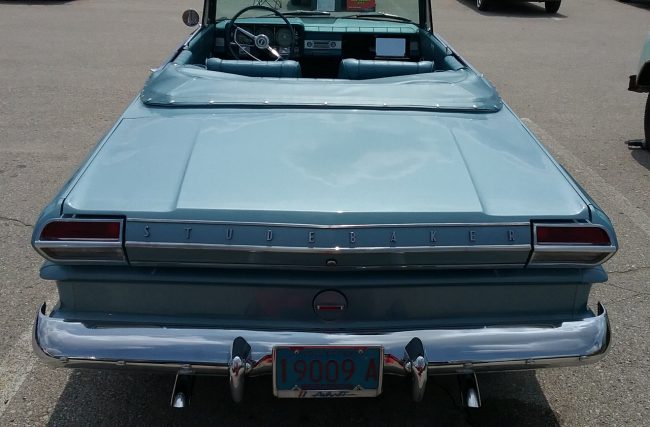
It was a good try; but with South Bend shut down, already gun-shy Studebaker buyers became even more skittish. In 1965, operating out of a Canadian facility originally intended for Dominion sales, Studebakers were technically imports in 1965-66.
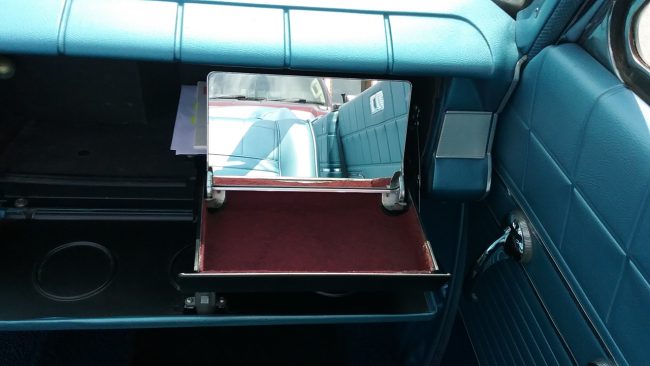
Glovebox vanity, a neat touch
Ultimately, the diversification-driven Studebaker board got their way, and in 1966 the car division was shut down in favor of STP car care products, Gravely tractors and Trans International Airlines. But handsome cars like these true blue 1964 examples remind us of what was once the oldest auto manufacturer in America. Even to the end, their cars were interesting.
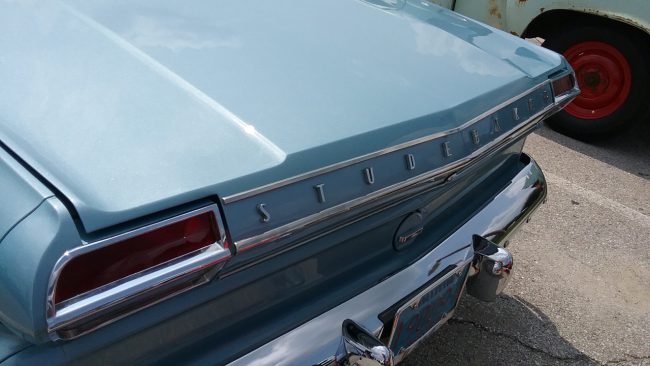
Note: All the Studebakers save the 1964 Cruiser were seen at a SDC zone meet in Iowa City on August 11, 2018. The Cruiser was spied at the Planes, Trains and Automobiles show in historic Geneseo, IL back in September 2012. Special thanks to my uncle, Dave Klockau, for texting me and letting me know about the terrific Studebaker club show! Being in the Quad Cities, I never would have known otherwise. And I’m planning more posts in the near future on selected Studebakers from this show as well. So stay tuned…







20 Comments
Most of Studebakers woes WERE self inflicted. There were many highlights, 53 coupes, 57 supercharged Golden Hawk, 63 R-2 Lark and obviously the Avanti, but more WTF times. Packard merger, keeping the flat head 6 long past when it should have been retired (then replacing it with a troublesome OHV 6), seriously overbuilt V-8 (meaning it also made it very heavy) and the biggest, as you mentioned, their labor cost per unit.
Shame, because they actually are good cars.
Source; currently own a 60 MY Lark VIII Regal.
New England, where I grew up had an amazing amount of loyal Studebaker owners who did anything to halt the tin worms and keep their beloved Studies going and road worthy .
Too bad they’re gone .
-Nate
As a kid up there, I remember my grand dad saving his drain oil and spraying it on the bottom of what ever car he had. Messy as hell, but did slow up the tin worm.
These days, you would likely go to prison for doing that.
The high break-even point (about 200,000 units annually) meant the antiquated South Bend plant had to run flat-out to earn a small profit, and hence Studebaker could least afford a strike, which the UAW took full advantage. Thus Studebaker paid higher labor costs than GM or Ford. Studebaker’s former wagon and buggy plant also couldn’t physically accommodate wider cars, so Studebakers always looked a bit too narrow compared to the competition, as least until the Lark came along with tidier length and overhangs that matched up better with the narrow width. The Grand Avenue Packard plant was actually more modern than the Studebaker plant, and Packard was in process of moving out of it to a former Briggs body plant, because they knew it wasn’t efficient enough. Packard also had new state-of-art plants for making their new V-8 engine and Ultramatic transmission. Yet for some some reason after merger with Studebaker, the more modern Packard plants were abandoned and they shifted all production to South Bend – just another example of the genius Studebaker management of that era.
Not sure the problem really was stupid management. It was for the time a premium car of a smaller size, a Volvo, a Rover, or a Cressida. That put the buyer among the ones looking at imports. They just don’t want something from South Bend made by Sherwood Egbert and the UAW. Evil businessman and blacks not an attractive combination to that market. I think that was the hope for moving to Canada at the end. Of course Canadians are like domestic USA buyers and gloriously tight fisted.
No it wasn’t entirely stupid management, but senile management. A big problem for both Studebaker and Packard is that they never developed a younger generation of talent to take over top leadership positions. Packard and Studebaker brought in some new talent from the outside towards the end, but the writing was already on the wall and there were insufficient cash or management talent to really change the direction of the firms. Studebaker needed money for new chassis/bodies and a new plant, and Packard needed some vision to buy next door neighbor Hudson for a mid-price line (instead of Packard clone Clippers), and invest in V-8s before 1955. Instead Packard drowned trying to save Studebaker, which was by far the weakest of the pre-war independents.
You talk a lot about the neat things they could do if they had some money. Remember the problem was that they did not have customers for the cars they had. So throwing more borrowed money at it was not going to help. It sure wasn’t the answer widening the line at Rambler/AMC. Instead finding a Volvo like niche was their best hope. There was no hope of taking on the big 3 on price, and almost entirely, American domestic buyers were extremely price sensitive.
The business plan in the end made some sense. A shoestring small Canada factory emphasizing import to reduce the domestic stigma. Chevy engines, they were better anyway and those fairly silly supercharged things were just publicity stunts and go against the quality image Stude was going for. Bringing in the Isuzu Belade below the Lark range to give dealers more volume. Going with the lefty car it was, a big push for Canadian handouts, image how generous Daddy Trudeau would have been a few years later.
Things had to go perfectly for it to work out. When they did not, pulling the plug to prevent bleeding was only sensible.
“those fairly silly supercharged things were just publicity stunts ”
Perhaps. It did however, starting in 1957, bring other buyers to the table that were desperately needed.
And as the old saying goes; you can sell an old man a young mans car, but you can’t sell an old mans car to a young man.
Gorgeous cars, Tom. I think I mentioned the story about my Great-Uncle’s 1962 Lark VIII. Upon his passing in 1970, we were his only living family; both of my older brothers were offered his Lark, neither one wanted to been seen in an “old man’s car” To have it now… Priceless.
Growing up, there was always a “secret” about Studebaker’s demise, but as an adult, one finds that it just mismanagement and short sighted business goals that did in the oldest US auto manufacturer. Sad to think that history would repeat itself 40 or so years later with the remainder of the Big Three.
For now, we can only appreciate what was and hope for better times…
Ah, the Studebaker Saga. The story oft-told, often with new releases of historical documents and figures, as the history fades into the distance and the principals, and their offspring, go the way of all flesh.
It’s hard for someone in our time to imagine it, but, yes, Studebaker was an industrial suicide. Four major steps to it: First, the high overhead and the FAILURE of Studebaker management to take their case to the union and ask for pay and work-rule easings.
Then, the cooking of the books, in the 1950s.
Then, the sale to Packard, under false pretenses. Packard, meantime, was in a world of hurt – while debt-free, they lost their body supplier, Briggs; and their sales were too low to justify constructing their own. Packard, under the “brilliant” management of James Nance, did not get an independent audit of the Studebaker books – or check the Studebaker body plant to find out whether it could make Packard car-bodies.
SPOILER: They could not. The South Bend plant was wildly obsolete; and Studebaker cars remained narrow into the 1960s for a REASON.
So now it’s the Packard team, holding the bag, with their own body supplier being sold to Chrysler. Fake financial books; an obsolete car line in Studebaker; an obsolete plant, and a fantasy breakeven point.
The only good move here was the Lark. Like the Gremlin a decade later, the hack-job Sawzall compact was first on the scene, and had, given its low-level of preparation, some staying power.
Then came the buying spree. Onan; STP, Gravely; and ALCO (formerly American Locomotive). That was the Studebaker-Packard exit-plan.
Sherwood Egbert was a whiz-kid ex-Marine who turned McCullough around – and he was brought in to wind down Studebaker. What nobody figured on, was that Egbert became a born-again pistonhead. He LOVED being a car-company CEO. He didn’t WANT to wind it down. If he did any formal reports, they’re apparently lost – but if he had, they would have shown that he thought the car business was still viable.
But Egbert, strong, young, and photogenic – and with a singular name that would stand out – got felled by the Big C. In those days it was almost-always terminal; and while he lived five more years, he was unable to continue.
Byers Burlingame, a bean-counter out of Packard, took over – and he would brook no nonsense. When the UAW contract expired in December, 1964…he just let it. And closed the plant.
The men on the engine line worked under a separate contract, set to expire in 1965. Again…Studebaker ran the line, halfheartedly; sending their engines to the Ontario plant…and when the contract expired, Studebaker put Chevrolet engines (GM-Canada) into their Lark-derivative cars.
Field-engineered. There was no more of a real engineering department; trial-fitting of possible source-engines and transmissions went on in a corner of the Hamilton plant. Like kids in a garage, doing an SBC swap.
Of course, all this failed. Gordon Grundy, the unlikely hero to carry Egbert’s legacy, pleaded desperately for more dealers and money for new models. But when the Motor Vehicle Safety Act of 1966 was passed…Burlingame decided it was time to end the farce and close it down.
Even though the miniscule operation was, by that time, making a profit. A couple million a year, which, given the low production run and the next-to-nothing investment, was remarkable.
And that was Studebaker’s trajectory. As the author knows, they never went bankrupt; they just continued to contract and sell their parts, until they were reduced to a commercial-vehicle leasing company in Houston.
That last little vestige died in the mid-1990s, taken over by a commercial bank.
Remember, the Studebaker dealers lived on as Toyota dealers and the Packard dealers lived on as Mercedes dealers. So the buyer got what they wanted, smaller cars with all the Americanness edited out.
It’s quite possible that the last Studebaker was built in Israel.
http://www.carsindepth.com/?p=3630
Didn’t the make the Avanti II on its original Studebaker chassis in South Bend until at least 1982?
Yes. Other than engine and trans it was as designed by Studebaker.
https://en.wikipedia.org/wiki/Avanti_(car)
Nate Altman (one of my personal heroes) and his brother kept the Avanti in production in South Bend (they bought a couple of factory buildings from Studebaker) but the Altman Avantis were never branded as Studebakers.
Very interesting article Ronnie. I’d heard they made Larks in Israel but didn’t know the details. That four-door open parade car is fantastic!
BTW I noticed a link at the bottom of that article that said “Editorial: Is Curbside Classic Trustworthy?” I wanted to read it but when I clicked the link it said ‘page not found.’
I guess I forgot to hit Publish. It’s live now.
I have one of the very last 63 MY Champ’s sitting next to my garage. Got it in a trade. Starts, runs, and drives but no title. Original 259 V8, auto trans, but base interior that was redone at some point. Believed to be a Milwaukee public works truck originally, based on the configuration, and the original paint color.
Still trying to figure out what I want to do with it, and if it’s financially worth it to get it back on the road.
In the event you do decide to fix up that Champ, here is a link for different parts vendors;
http://www.studebakervendors.com/
If you don’t decide to fix and just want to sell it, they are still pulling decent money. Depending on condition of course.
Really nice cars, but Studebaker, like all independents was at the big poker table against some pretty competent players (GM, Ford, Chrysler) with LOTS more money. They could zig and zag for a while, but eventually their fate was cast. The big three kept raising the stakes and eventually, Studebaker, like all the others had to fold. But, what a way to go out in ’64!